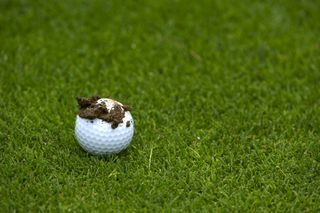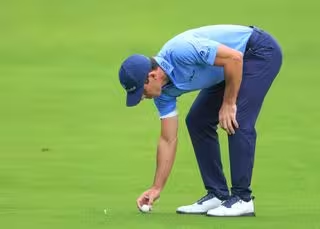During the off-season, or even In the main season if the weather has conspired to leave fairways in a less-than-optimal state (either wet and muddy or sometimes bare and patchy with insufficient growth), many clubs introduce Local Rules in the form of preferred lies (often referred to as Winter Rules out of season) to allow balls on the fairways or other closely mown areas to be lifted, cleaned and placed in a preferred spot.
Billy Horschel taking a preferred lie during the 2022 BMW PGA at Wentworth
(Image credit: Getty Images)
The R&A ‘s website explains the rationale and purpose of Model Local Rule E-3, which covers preferred lies: “When temporary abnormal conditions might interfere with fair play, the affected parts of the course can be defined as ground under repair. But adverse conditions such as heavy snows, spring thaws, prolonged rains or extreme heat can sometimes damage the course or prevent use of heavy mowing equipment. When such conditions are widespread on the course, the Committee can choose to adopt a Local Rule for “preferred lies” to allow fair play or help protect some or all fairways.”
Allowing the fair playing of the game when fairway conditions are less than ideal means players are less likely to suffer a ‘mud ball’ flight, or worse still, a clump of mud on the ball right at the point of impact. However, The R&A also advises that preferred lies should be withdrawn as soon as conditions warrant it, rather than being left in force indefinitely.

When preferred lies are in force on the fairways you may clean the ball to prevent a potential ‘mud ball’ flight
(Image credit: Getty Images)
In their Winter Rules form, preferred lies will typically be in force from some time in October to some time in March or April, but in 2024, the very wet off-season and long recovery period meant some courses were still playing preferred lies on some or all fairways into the summer… even into August at one course I played! The Model Local Rule goes on to say such temporary relief is not recommended for use away from areas cut to fairway height and may not be introduced once play has started for a stroke play round to ensure no players gains an unfair advantage.
When taking preferred-lie relief under the Local Rule, it is a good idea (although strangely not obligatory) to first mark the ball’s position, before lifting and cleaning it without penalty. You must then place the ball (not roll it or nudge it with the toe of a club) on to a spot…
..
Click Here to Read the Full Original Article at Golf Monthly…
